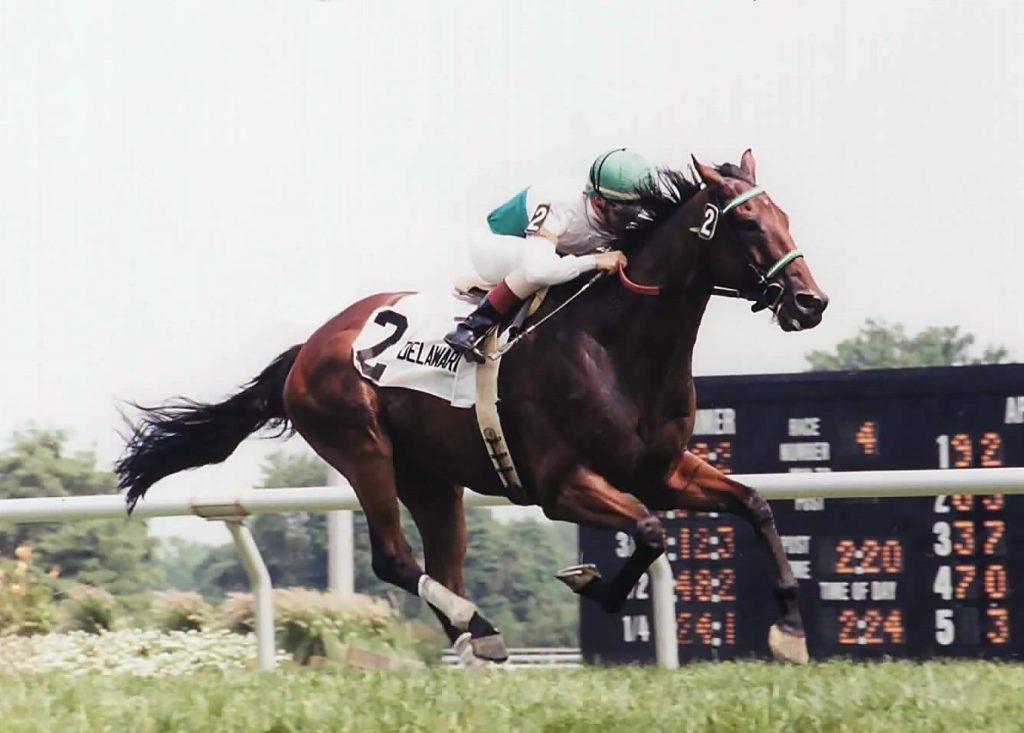In a typical year, 1,600 Pennsylvania-breds compete on the racetrack for average earnings of $27,600. Of the 50,000+ who have raced across the globe since 1985, only an elite group of 31 horses have broken the seven figure mark in earnings. Over the course of summer 2020, the Pennsylvania Horse Racing Association will be chronicling a ten-part series featuring the select group of Pennsylvania-breds who reached the unique and rare accomplishment of $1,000,000 in racetrack earnings. Join us to celebrate and remember some of the greatest racehorses the Keystone State has produced.
Mrs. Lindsay: The French Filly
For decades, Marshall and Bettina Jenney’s Derry Meeting Farm has bred top-class racehorses at their Cochranville base. Marshall Jenney bred the three-time, G1-winning millionaire Yankee Affair, Irish and English champion Mrs. Penny, and even had a hand in influential sire Danzig. In total, Derry Meeting has bred three Pennsylvania-bred millionaires: Yankee Affair, Lord Admiral (highlighted in Part 1), and Mrs. Lindsay.
Following Marshall Jenney’s death, Bettina took over management of Derry Meeting and continued the family tradition. In 2003 she sent homebred broodmare Vole Vole Monamour to champion turf horse Theatrical, and on February 18th, 2004, she delivered a chestnut filly.
Named Mrs. Lindsay, Bettina Jenney would end up campaigning the filly herself after she did not meet reserve at the 2005 Keeneland September Yearling Sale. It was a fitting homecoming as Mrs. Lindsay was fifth-generation Derry Meeting-bred on her dam’s side, tracing all the way back to Marshall Jenney’s champion Mrs. Penny. Mrs. Penny’s best daughter Mrs. Jenney produced only two foals before passing, a G1 winning son in Unaccounted For and a French stakes winning daughter in A Votre Sante. A Votre Sante would only end up producing three foals herself, with Mrs. Lindsay’s dam Vole Vole Monamour being her only daughter.
Like her dam and granddam, Mrs. Lindsay was sent to France to begin her racing career for the barn of trainer Francois Rohaut. She only started once during her two-year-old season of 2006, finishing a respectable third at Longchamp.
Starting her three-year-old year on March 9th, 2007, Mrs. Lindsay romped home to win a 1-3/8th mile maiden race by 4 lengths at Fountainbleu. Her impressive debut earned her an automatic delve into group company, and the filly made her next start in the Group 3 Prix Penelope. Tracking early pacesetter Sismix, Mrs. Lindsay rallied up alongside in the final furlong and poked her head in front in the final strides to win her first group race by a short neck.
Bettina Jenney and Fancois Rohaut knew they had a nice filly on their hands, and the decision was made to march on to the French classic races. The Group 1 Prix de Diane serves as France’s equivalent to the Kentucky Oaks. Staged two months after the Prix Penelope, Mrs. Lindsay trained up to the premiere event and entered as a 14-1 outsider. She was easily overlooked with only three races under her belt, but the talented filly was able to stave off all challengers except one, eventually falling 1 ½ lengths short to the Godolphin-owned West Wind.
With a classic placing under her belt, Mrs. Lindsay continued her sophomore season in high regard. Her first race after her Prix de Diane runner-up effort came in a head-scratching, off-the-board performance in the 1-9/16th mile Group 3 Prix Minerve. With questions of Mrs. Lindsay’s potential distance limitations arising, Jenney and Rohaut were undeterred and decided to make a return to the highest level in the 1 ½ mile Group 1 Prix Vermeille. The Prix Vermeille has established itself as one of France’s most elite contests for fillies and mares in the second half of the year, and a rematch with Prix de Diane winner West Wind loomed.
One month after her poor performance in the Prix Minerve, Mrs. Lindsay went to post in the Prix Vermeille as a 16-1 longshot. After sitting just off the early leader, the filly took control approaching the 3 ½ furlong pole. West Wind was uncoiling a massive run from the back of the field, carrying her from ninth to second by the final furlong, but Mrs. Lindsay dug down gamely to enact revenge on her rival by three-quarters of a length.
With the Group 1 level conquered in France, Mrs. Lindsay traveled to Ontario, Canada for the $1 million Grade 1 E.P. Taylor Stakes at Woodbine. Going off the 7-5 favorite, Mrs. Lindsay took up her customary stalking position. With Canadian Triple Tiara winner Sealy Hill getting first run on her approaching the top of the stretch, Mrs. Lindsay ducked down inside and rallied along the rail to collar Sealy Hill approaching the final 50 yards. She soared under the wire a half length in front to set a new stakes and track record of 2:00.68 for 1 ¼ miles. Her stakes record still stands today.
The E.P. Taylor was Mrs. Lindsay’s final race of the year and would unfortunately also end up being the final win of her career. Although she returned as a four-year-old in 2008, Mrs. Lindsay never regained her three-year-old form and was retired following her third consecutive off-the-board finish while fourth in the Group 2 Prix de Pomone on August 10th, 2008.
During her fleeting career, Mrs. Lindsay ran ten times with four wins, one second, and one third for earnings of $1,201,620. She proved herself one of the best of her crop while winning three group/graded stakes events in France and Canada, two of which were G1, and placing in a French classic.
Initially taking up broodmare duties in Ireland, Mrs. Lindsay returned to Derry Meeting Farm to deliver her third foal, a colt by Invincible Spirit. Mr. Owen turned out her best foal to date with three French stakes wins and a third-place finish in the French 2,000 Guineas. Mrs. Lindsay was exported to Japan the following year and currently resides at Shadai Farm.
Rochester: The Ageless Wonder
Of George Strawbridge’s record five Pennsylvania-bred millionaires (of which we have already recalled Smart Bid and Lucarno), Rochester was the one who competed on the racetrack for the longest period of time. From 1998 to 2008, the hard-knocking gelding competed at numerous tracks across the United States and abroad.
Strawbridge campaigned Rochester’s dam Central City, a British-bred daughter of Midyan who was a Group 3 winner in France before finishing her racing career in the United States. He sent Central City to champion sire Green Dancer for her second foal, and Rochester was born on June 3rd, 1996.
Like his mother, Rochester was sent to France to begin his racing career, but the foray would prove unsuccessful. After only making one start at age two and another at age three, Rochester was returned to the United States to continue his racing career as a four-year-old under the tutelage of Hall of Fame trainer Jonathan Sheppard.
Making his American debut on October 14th, 2000, Rochester sailed to a last-to-first victory by 1 ½ lengths at Delaware Park in his only start at age four. Returning at age five, Rochester returned to the winner’s circle in his third start, taking an allowance at Keeneland by a widening 4 ¾ lengths.
Summering at Delaware Park, Strawbridge’s charge continued to improve while winning three allowances and finishing second in a fourth. He earned himself a try in stakes company and made his debut in the Sycamore Stakes at Keeneland. Rochester settled comfortably towards the back of the pack before unleashing a run that had him find the lead by the final furlong. Chorwon issued a late surge that led to both horses hitting the wire together, but the photo revealed Rochester holding on by a nose to win the first stakes race of his long career.

(Lydia Williams Photo)
Returning at age six, Rochester tallied second-place efforts in a Tampa Bay allowance and the G3 Elkhorn Stakes at Keeneland before finding the winner’s circle again in the Cape Henlopen Stakes at Delaware Park. He garnered another second in the Caesar Rodney Handicap before stepping back into graded stakes company in the Grade 3 Kentucky Cup Turf.
Sent off at 11-1, Rochester settled in midpack until the field approached the final furlong, finally uncorking a run that carried him to the lead. He didn’t look back once he reached the front, drawing away to a 2 ½ length score to land his first graded stakes victory. Rochester returned to Keeneland to successfully defend his title in the Sycamore Stakes, rallying from the back to run down longshot Roxinho by a comfortable length. He ended his banner year with a fourth-place effort in the G1 Hollywood Turf Cup and a third in the G2 W. L. McKnight Handicap.
Although the beginning of Rochester’s seven-year-old season started out slow, he was gelded and began to find his footing again halfway through the year. He finished a close second in the Grade 3 Louisville Handicap before finishing third in the Eight Thirty Stakes and second in his Cape Henlopen defense. Another attempt at a title defense loomed in the Grade 3 Kentucky Cup Turf at Kentucky Downs.
Running a race very similar to his winning trip the year prior, Rochester turned into the homestretch with a barrage of company. With Art Variety and Quest Star to his inside, the three dueled in close company towards the wire. Rochester continued to close the advantage on his foes, but Art Variety drifted out approaching the wire, bumping into Quest Star who in turn bumped into Rochester. As the wire passed overhead, Art Variety still had his head down ahead of Rochester, who was another half length in front of Quest Star. Both Robby Albarado aboard Quest Star and Eddie Martin, Jr. on Rochester claimed foul against the unofficial winner. Art Variety was subsequently disqualified and placed third with Rochester inheriting the victory and winning the Kentucky Cup Turf for the second consecutive year.
As an eight-year-old, Rochester continued to pick up checks with seconds in the G3 Elkhorn and G3 Louisville (becoming a millionaire) and a fourth-place effort in the G1 Sword Dancer Invitational before attempting to win the Kentucky Turf Cup for a third year in a row. He finished a respectable second before ending his year with a third in the G3 Sycamore Stakes.

The hard-trying gelding’s nine-year-old year ushered in more Grade 3 placings in the Elkhorn, Louisville, and Kentucky Cup Turf before another crack at the Sycamore Stakes. By this point, Rochester had not visited the winner’s circle since he was handed the victory in the Kentucky Cup Turf two years prior. Regardless, the betting public let him off at 6-1, and Rochester rewarded them handsomely. Making his customary late run, the gelding looked much like his old self when running down his rivals to win by a widening 3 ¾ lengths.
While returning as a ten-year-old in 2006, Rochester began to feel his age and struggled to find his success from past years. From his five starts that year, the gelding’s best effort was a third-place finish in the G3 Kentucky Cup Turf. At year’s end, George Strawbridge decided to retire his gallant gelding to live out his days on his Pennsylvania farm.
His retirement didn’t last very long. At the age of twelve in 2008, Rochester was put back in training with jumps trainer Sanna Neilsen for a crack at steeplechase racing. In his first start over jumps, Rochester blew out to a 14 ¾ length allowance victory over three miles on the timber. He returned eleven days later on May 4th, 2008 to record the official final start of his career, battling to a hard fought half length allowance score at Winterthur. With his brief steeplechase career coming to a close, Rochester earned his permanent retirement.
From his ten years on the racetrack, Rochester entered the starting gate fifty-three times, winning thirteen races with eleven seconds and three thirds for total earnings of $1,232,266. He consistently competed at the graded stakes level from 2002-2006, winning three graded affairs from six total stakes victories and placing in fourteen others. He reigned in Keeneland’s Sycamore Stakes on three separate occasions and took home Kentucky Downs’s Kentucky Cup Turf twice. Now twenty-four-years-old, Rochester continues to live out his days on Strawbridge’s farm.
Russian Rhythm: Taking England by Storm
Brushwood Stable’s storied past has led itself to a record five Pennsylvania-bred millionaires. Betty Moran established a stellar reputation for her Pennsylvania farm by buying, selling, and campaigning world-class racing stock for decades. Our series has already covered two of Mrs. Moran’s state-bred millionaires in Master Command and High Yield, but her exploits in contributing to racing at the highest level reached far beyond the United States.
The 1986 Keeneland November Sale offered a unique opportunity. Irish broodmare Balidaress had been exported to the United States the year before and was being offered at auction in foal to world-class sire Nureyev. At the time of her offering at Keeneland, Balidaress had already foaled two Group 1 winners and an English/Irish champion. The thirteen-year-old mare hammered at $1,600,000, a top five price at the sale which offered 1,900 horses, with bloodstock agent Barry Weisbord signing the ticket on behalf of Elizabeth Moran.
Betty Moran sent Balidaress to British Triple Crown winner Nijinsky for her first foal on her behalf, and the mare produced a chestnut filly in 1988. Balistroika would never make it to the racetrack, but Mrs. Moran kept her at her Pennsylvania farm for broodmare duties. By the time she was sent to Kingmambo for her sixth foal, Balistroika had already produced two $400,000 yearlings. She foaled her sixth foal, a chestnut filly, on February 10th, 2000.
The young filly quickly garnered high expectations and was offered as a weanling at the 2000 Keeneland November Sale where she brought $370,000 from Surfside Enterprises. With such a beautifully European influenced pedigree, the filly was exported to England and offered as a yearling at the Tattersalls Houghton Yearling Sale, bringing around $678,770 USD. Cheveley Park Stud, one of the most successful breeding and racing operations in Europe, signed the ticket.
Cheveley Park named the filly Russian Rhythm and sent her to trainer Sir Michael Stoute, often the handler of the operation’s highest class racehorses. The filly made her debut as a two-year-old at Newmarket on June 28th, 2002, running down the pacemaker in the final strides to win by a neck. She returned the following month to make her stakes debut in the Group 3 Princess Margaret Stakes at Ascot, where she charged from last to first to post a 1 ¼ length victory as the even money favorite.
Stepping up to the next level, Russian Rhythm next appeared in the Group 2 Lowther Stakes at York. Sitting much closer than her previous start, the filly took command approaching the finish and held off the late challenge from Danaskaya to score by 1 ¼ lengths. With a potential year-end championship beginning to materialize, Russian Rhythm’s sights were set on the Group 1 Cheveley Park Stakes, a race named after her owners that serves as one of the most elusive races for two-year-old fillies in all of Europe.
Sent off the heavy, odds-on favorite in the short field of six, Russian Rhythm assumed command in the Cheveley Park with a quarter mile left to travel. The challenge came from Airwave, who loomed alongside approaching the final furlong. To the surprise of many, Airwave continued on past Russian Rhythm to post a 1 ½ length upset and quash any championship dreams. The Cartier Award for Champion Two-Year-Old Filly went to French Group 1 winner Six Perfections.
Having won three of her four starts at age two, Russian Rhythm was put up for the year with the following year’s goal being the first of the British classics for fillies, the 1000 Guineas. With the Guineas staged on the first Sunday in May, Sir Michael Stoute opted to train his filly directly up to the classic with no prep race. Meanwhile, two-year-old champion Six Perfections notched another stakes win in the Prix Imprudence to bring her winning streak to four in a row. Although making her first start outside of France, the 1000 Guineas was viewed as Six Perfections to lose and she was installed the heavy 7-4 favorite. Russian Rhythm, having not been seen since her disappointing loss in the Cheveley Park and acting up before the race, was discounted at odds of 12-1 for her first start beyond six furlongs.
With a large field of nineteen assembled for the Group 1 1000 Guineas, Russian Rhythm and Six Perfections found themselves alongside each other on the far outside of the starting gate. When the gates sprung, both fillies settled towards the back of the pack with Six Perfections drafting directly behind Russian Rhythm. Six Perfections eventually progressed alongside her foe, but it’s a move that might have proven costly. As the real running began, the favorite found herself trapped behind a wall of horses as she checked off heels and got shuffled back. Meanwhile, Kieren Fallon aboard Russian Rhythm expertly switched his filly towards the middle of the pack and weaved her between horses to get within contention. Six Perfections was taken to the far outside to finally get clear sailing, but it was too late. Russian Rhythm was already bursting between leaders Intercontinental and Soviet Song to take the lead. Six Perfections could only hopelessly chase as Russian Rhythm powered to the front and held on to post a 1 ½ length upset. Her victory marked the first 1000 Guineas success for Cheveley Park.
On a mission to prove her Guineas success was no fluke, Russian Rhythm squared up for the Group 1 Coronation Stakes at Royal Ascot against Guineas fourth-place Soviet Song. Sitting in third in the early going, Russian Rhythm made her bid for the lead approaching the final quarter mile. With Soviet Song rallying along the outside, both fillies powered away from the rest of the field. Russian Rhythm continued on with the advantage, again repelling her foe to cross under the wire a comfortable 1 ½ lengths in front.
For her next start in the Group 1 Nassau Stakes, Russian Rhythm faced two new challenges: facing older horses for the first time and stretching out to a mile-and-a-quarter. Regardless, she was still installed the heavy 4-5 favorite in the field of eight. Initially tracking in third, Russian Rhythm encountered traffic trouble and lost position in the waning stages of the race as Ana Marie took command of the lead. Kieron Fallon was finally able to steer his filly in the clear to engage with the pacesetter, and Russian Rhythm bore down on her older foe as the wire was quickly approaching. In a last gasp, she drew even and stuck her nose in front inside the final 50 yards to win her third consecutive Group 1 race by a neck.
Having conquered her own sex in her own age group and beyond, the next step for Russian Rhythm was open company against older males. The elusive G1 Queen Elizabeth II Stakes run over a mile was the logical spot. Set at odds of 3-1, Russian Rhythm would go off as second choice behind the globetrotting five-year-old male Falbrav, who had already garnered Group 1 victories on the year in the Prix d’Ispahan, Coral-Eclipse, and Juddmonte International.
In one of the most valiant efforts of her career, Russian Rhythm ran on gamely to fend off all challengers except her sternest foe. Although she had zeroed in on her target, Falbrav had first run on the younger filly and was simply too good. She tried her heart out and crossed the line in second, two lengths behind Falbrav. Falbrav continued his globetrotting ways, losing the G1 Breeders’ Cup Turf by a head before taking down the G1 Hong Kong Cup in the final start of his brilliant career. He was awarded the Cartier Award for Champion Older Male.
Russian Rhythm had one final race up her sleeve and took a crack at the Group 1 Champion Stakes, which closed out the British racing scene with the year’s top horses. Although sent off a very close second choice, Russian Rhythm turned in the poorest performance of her career when finishing fifth, 6 lengths behind the winner Rakti. It was the only time in her career where she finished worse than second. Despite the disappointing end to her year, Russian Rhythm was voted Champion Three-Year-Old Filly at the Cartier Awards.
Russian Rhythm returned as a four-year-old, but her season was brief. On May 15th, 2004, she made her only start of the year in what would be her final career race in the Group 1 Lockinge Stakes. In her last display of brilliance, Russian Rhythm fended off a field of fourteen males to secure her fourth Group 1 victory by a half length over longshot Salselon.
From her three seasons on the track, Russian Rhythm won seven of ten starts with two second-place finishes for earnings of $1,260,794. She won four Group 1’s from six total group races, including her upset British classic victory in the 1000 Guineas. While Cheveley Park remains a frequent face on the European racing scene, Russian Rhythm remains the only horse they ever campaigned to win four Group 1 races, and she remains in a tie with Echelon for most overall group victories at six. Following a bout of colic at the age of fourteen, Russian Rhythm was euthanized at Cheveley Park Stud. Although she never replicated anything close to herself, three of her daughters went on to produce Group 3 winners.











